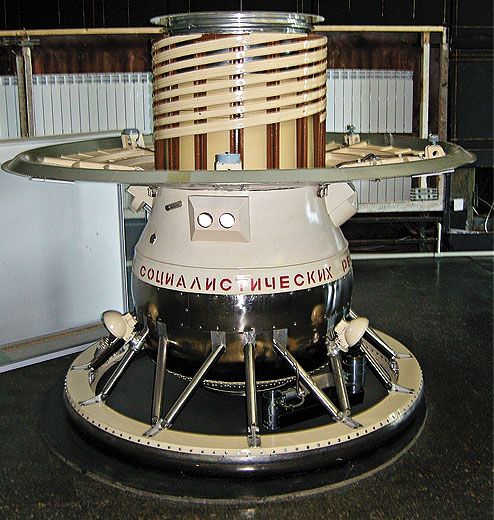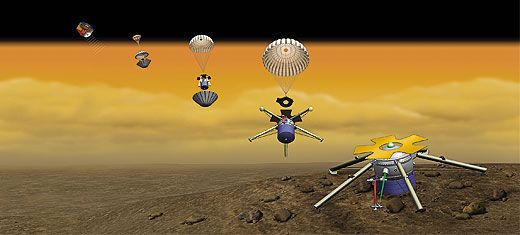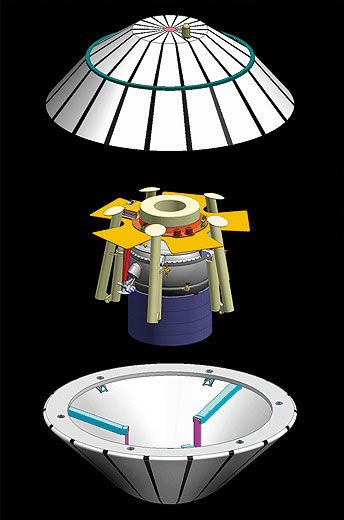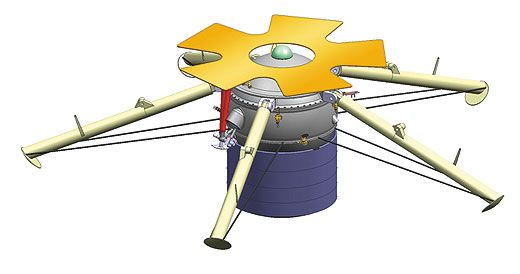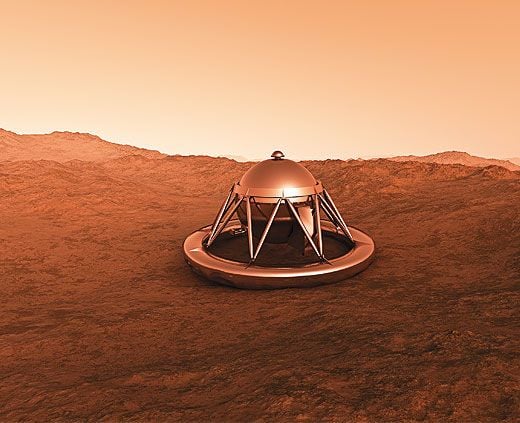Forbidden Planet
We’ve been to the moon. Mars is easy. But landing on Venus? That’s tough.
/https://tf-cmsv2-smithsonianmag-media.s3.amazonaws.com/filer/Forbidden_Planet_FLASH.jpg)
Over the past 15 years, astronomers have identified about 500 planets around distant stars, and are now closing in on the ultimate prize: finding a world similar to our own, with conditions right for life. Such a discovery would be a technological triumph and a historic scientific achievement.
But we should never have had to look so far.
Venus—the planet closest to us, and our twin in terms of size and mass—should by rights have developed in parallel to Earth. Instead it became a monstrosity, the relative we hardly mention and rarely visit. In the planet’s dense atmosphere, carbon dioxide, a greenhouse gas, somehow built up to toxic levels, now accounting for 96.5 percent of Venus’ air, as compared to 0.04 percent of Earth’s. The runaway greenhouse effect made Venus hotter than a self-cleaning oven, with atmospheric pressures equivalent to those found half a mile under Earth’s oceans. Says space physicist Larry Esposito of the University of Colorado at Boulder, “Dante’s vision of hell is real, and it is the planet next door.”
Maybe that’s why he likes studying it. Esposito began his space science career with NASA’s Pioneer Venus missions in 1978, and in 1995 he was the first to observe the planet with the Hubble Space Telescope. Landing on Venus has proven a more elusive goal, though. No one has sent a probe to the surface in 25 years, and NASA has never even tried. Since the Magellan orbiter mapped Venus with radar in the early 1990s, the U.S. space agency has focused its attention primarily on Mars and the outer planets.
Meanwhile, Esposito has pitched Venus mission proposals to NASA and the space agencies in Europe, Russia, and Japan, with mixed success. His curiosity about the planet—“particularly the comparison between Venus, Earth, and Earth-like planets”—drove him on, he says, and he never lost interest. “I’ve been busily working on [concepts] for 30-some years. I’ve always had a plan for a future mission to Venus. Every year it changes.”
Esposito’s time may finally have arrived. As greenhouse gases like CO2 build up in Earth’s atmosphere, scientific priorities are shifting, and closer attention is being given to proposals to study a neighboring planet that may be an object lesson for Earth. Last December, NASA gave Esposito $3.3 million to further develop his Surface and Atmosphere Geochemical Explorer (SAGE) concept, which would place a small probe equipped with cameras, spectrometers, and other instruments on the Venusian surface. If NASA decides to fund SAGE (next year the agency will choose between it and two other proposed missions: one to an asteroid, the other to the moon), then a spacecraft could return to Venus by 2018, becoming the first to visit there since the Soviet Union’s Vega 2 in 1985.
In the 1970s and 1980s, the Soviets practically tried to colonize Venus, sending more than a dozen landers and orbiters. One, Venera 13, which landed on March 1, 1982, lasted 127 minutes before expiring. At the height of the program, tens of thousands of people were working on the Veneras, according to Viktor Kerzhanovich, a Venera veteran and now a planetary scientist at NASA’s Jet Propulsion Laboratory in Pasadena, California. In true cold war style, he says, the Soviet Union added as many zeroes to the Venera budget as were necessary to beat the Americans.
Given their prior successes, it’s not surprising that Russians like Kerzhanovich are eager to go back to Venus: “When the opportunity comes, I hope to be part of an American mission,” he says.
THERE’S A COMMON PERCEPTION that the Soviet Venus probes were crushed by the sheer weight of the planet’s atmosphere. That’s (mostly) false. But the truth’s not much better. Venus is the most inhospitable world in the inner solar system, boiling hot and rife with airborne acids. Developing the technologies to withstand those conditions—even for one afternoon—will take years and cost hundreds of millions of dollars. From the first brush with Venus’ atmosphere, the lander will be fighting thermodynamics, and it will lose.
The proposed SAGE lander would look, from the outside, like a giant ball bearing. But it will behave more like an insect, one of those poor bugs that lies dormant for decades, then claws out of its cocoon, sticks out arms and antennae in a frenzy of activity—and croaks. At least cicadas get weeks to romp. A Venus lander gets hours.
The dangers start more than 80 miles above the planet’s surface, after the lander is dropped off by a carrier spacecraft, and get worse as the lander descends through the atmosphere. The engineers designing SAGE have had to think up a different solution for each hazard. Thick clouds of sulfuric acid at 40 miles up explain why the planet’s surface is invisible from Earth. As the lander parachutes down, it also has to contend with lightning and withstand winds up to 200 mph.
At an altitude of about nine miles, well below the cloud decks, SAGE finally begins to take pictures of the surface. So few photographs exist of Venus (all taken by the Venera landers) that every image of the surface will be precious. But aside from showing impressive volcanoes, the landscape shots might be pretty blasé. There are no vistas of lakes or forests, and the air will be hazy—a dreary low light like the fifth rainy morning in a row. The thick atmosphere absorbs high-frequency blue light, so the resulting colors, or rather color, of the surface will be both dull (a kind of rusty yellow) and intense (relentless, unbroken).
At eight miles above the surface, according to JPL planetary scientist Suzanne Smrekar, the carbon dioxide in Venus’ atmosphere becomes so dense that it turns “supercritical.” Supercritical carbon dioxide is a gas-liquid mix that can eat through metal, and SAGE is designed to keep this nasty stuff from entering the sealed vessel.
For protection from the crushing atmospheric pressure—1,300 pounds per square inch—the lander will be roughly spherical, the strongest geometric shape. SAGE’s core—where the computer circuits are housed—will be surrounded by an inner titanium pressure vessel. The one redeeming quality of the heavy atmosphere is that it cushions the lander’s descent. Terminal velocity on Venus is a leisurely 25 mph—so slow that the parachute is no longer needed after the spacecraft is 42 miles above the surface.
There is no upside to the broiling heat, however. “Temperature is the thing that will kill you the quickest,” says Smrekar. To protect circuits and batteries, she and others are testing advanced insulation materials, like lithium nitrate, a kind of salt that absorbs heat as it melts from a solid to a liquid. This “phase changing” material could be sandwiched between layers of other insulators for extra protection.
As for where SAGE might land on Venus, in some ways it doesn’t matter. Four-fifths of the planet is volcanic plain, with weather more uniform than the Sahara. Venus has no axial tilt, so its poles get little light, and it rotates slower than most people walk, just once every 243 Earth days, exposing whole hemispheres to the sun for weeks. The forecast for Venus is always the same, day or night, equator or antipodes, on the sunny side or on the side facing black space: 850 degrees Fahrenheit, high pressure.
Nevertheless, scientists have diligently scouted landing sites, because wherever SAGE touches down, it will remain. Unlike the recent Mars rovers, the Venus lander will have no wheels or locomotive apparatus of any kind—a mobile explorer would have been too expensive and wouldn’t have gotten far in just a few hours anyway.
The SAGE team has proposed landing on the slopes of Mielikki Mons, a volcano 200 miles wide but just 4,800 feet high. That low grade is typical of Venusian volcanoes, which are like Hawaiian volcanoes in that they ooze lava rather than erupt explosively, building up a massive mountain over time. Based on recent imaging of the region around Mielikki Mons by Europe’s Venus Express orbiter, scientists think the volcano might have recently been active.
Lava flows have shaped the Venusian landscape the way plate tectonics have shaped Earth’s, and the lander will spend much of its short life sampling the terrain for clues about Venus’ past. Lasers from two portholes above the sphere’s waist will zap the soil, vaporizing small patches of ground. SAGE will also blast a neutron pulse at the soil, then examine the resulting gamma ray spectrum. Both experiments will tell scientists what minerals and elements the soil contains. Cameras looking out four other portholes will take panoramic pictures and microscopic shots, while other instruments sample the atmosphere.
Perhaps most important of all, SAGE will drill into the surface “weather rind” to get at the virgin soil underneath. This might prove the trickiest part of the mission, since the drilling arm will be exposed to Venus’ melting heat.
Back in the 1970s, Soviet scientists were shocked by the softness of the weather rind—one Venera probe took just two minutes to drill down an inch. The soft Venusian crust can conceal bits of harder material, however—nuts in the brownie—and robotic drills have been known to struggle with differences in rock density. So the SAGE drill may have to work harder to get to the soil underneath. The depth of the weather rind is in fact one of the things the mission will try to determine.
What scientists really want to know about Venus—beyond what the rocks are made of—is how the air, volcanoes, and surface interacted to bring the planet to its current boil. In other words, how the planet works as a system, and how that system went awry. “Venus is like the Earth, but has taken a different evolutionary path,” says Esposito. “And everything from its center to the top of the atmosphere plays into and contributes to those different evolutionary paths.”
Answering the question requires lots of data, and the lander will have to gather its information without human supervision. The pictures and other data will arrive at Earth only after the lander has finished its work on the surface.
To ensure its survival on Venus, the SAGE lander will have to endure grueling trials in several test chambers, some new and some old. NASA’s Venus test chambers from the Pioneer days simulated the surface temperature just fine, but didn’t bother duplicating the carbon dioxide atmosphere, on the assumption that it posed no threat to spacecraft. No one is making that mistake this time around; the new chambers are toxic kilns.
So far, Smrekar’s team has tested mechanical parts and materials in chambers up to two feet in diameter, sometimes observing them through small windows. (Nothing has failed yet.) To simulate the spacecraft’s aerodynamic stability in the upper atmosphere of Venus, the engineers will test it in a wind tunnel. For simulating the lower atmosphere, they will place it in a water tank.
One item of vital concern is the communications antenna. The thick clouds around Venus muffle radio waves, and SAGE won’t have much lung power to begin with. Nor will it have orbiting satellites to communicate with, as the Mars rovers do. All the lander’s data will be beamed up to the spacecraft that dropped it off, and from there relayed to Earth. As with the rest of the SAGE hardware, the communication system has to work in terrific heat.
Unfortunately, beyond a certain temperature—about 250 degrees Fahrenheit—commercial silicon electronics crap out, and the temperatures on Venus are hundreds of degrees higher than that. Semiconductors made of silicon blended with carbon, or gallium blended with nitrogen, might be hardy enough.
Or, the engineers could revive a technology from the 1950s, says Sanjay Limaye, a University of Wisconsin planetary scientist. Vacuum tubes turned out to be impractical for computers for a number of reasons, one being that they blazed so hot that they eventually popped in air that was many degrees cooler. But that heat makes them perfect for Venus, with its higher ambient temperature.
“We used to know how to do high-temp electronics when we had vacuum tubes,” says Limaye. And even though some of that knowledge has been lost after decades of using silicon circuits, he thinks tubes could be adapted for Venus radios—provided they’re smaller than the ones used in 1955 Zenith TVs.
ANY VENUS LANDER launched in the near future will live on the surface five hours, at most. Whether that’s long enough “depends on what your perspective is, whether you’re a glass half-full or half-empty person,” says Limaye. Even three hours gives a spacecraft time to collect data, take pictures, and do a little drilling. But to really understand how the Venus system works over time—that requires longer missions and new technologies.
Insulation won’t be enough. Long-duration (weeks-long) landers will require “active” cooling—refrigeration—says planetary scientist Mark Bullock of the Southwest Research Institute in Boulder, Colorado, who heads the team designing SAGE’s camera. Future Venus landers would basically be Frigidaires, devoting 70 percent or more of their power to staying cool. They will more than likely need multi-stage cooling: fridges within fridges. The only way to achieve that, says Bullock, is with nuclear power.
Other scientists have speculated beyond rovers to Venus aircraft. To investigate how a planet that rotates so slowly can generate such powerful winds, some suggest penetrating the acid clouds with a Teflon-coated helium-filled balloon. Scientists like Geoffrey Landis at NASA’s Glenn Research Center in Ohio have proposed sending an autonomous airplane with the rover. Landis points out the advantages of this one-two combination: The airplane would fly in the cooler upper atmosphere, which is friendlier to electronics. If most of the computer brain power were placed on the airplane, it could direct the rover from above.
With these kinds of tools, scientists could really start to unravel the mysteries of Venus: Why the planet doesn’t have plate tectonics, what happened to its water, and the Big Question: Could the same runaway greenhouse effect happen on Earth? It’s still not clear which one of the twin planets is the anomaly, says Smrekar. “We have two end members of [the spectrum of] Earth-like planets, and it will be interesting to see which is more common.”
SAGE may not give us all the answers we want, but if its mission is approved, the spacecraft will literally die trying. The first bytes of data should arrive at mission control—causing the scientists and engineers to erupt in cheers—after the lander has finished its planned work and started to succumb on Mielikki Mons, 24 million miles away. Eventually heat will pierce its inner circuits, kinetic energy will rattle its molecules harder and harder, and hiccups will start to appear in the transmissions.
As Lori Glaze of NASA’s Goddard Space Flight Center in Greenbelt, Maryland, envisions it based on work she’s done on other Venus mission concepts, the lander’s death will not be peaceful—no “Daai-sy, Daaaaai-sy” sign-off, followed by silence. After the batteries shut down, they will continue to bake in the 850-degree heat. Soon after, says Glaze, they will almost certainly explode, and the blast will probably breach the titanium pressure shield around the inner electronics. When the lander stops shuddering, the toxic air will go to work, eating any exposed wires down to the nubs, and the carbon dioxide will bleach any of the lander’s decorations (like American flags). All the metals will corrode, and the supercritical CO2 and acids and ocean-like pressure—all the hellish forces of Venus—will do what they do best, and destroy the lander piece by piece.
Sam Kean is the author of the New York Times bestseller The Disappearing Spoon: And Other True Tales of Madness, Love, and the History of the World from the Periodic Table of the Elements (Little, Brown, 2010).
